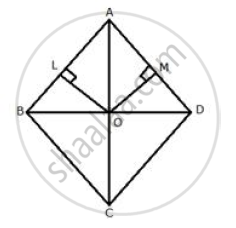Advertisements
Advertisements
Question
State the locus of a point in a rhombus ABCD, which is equidistant
- from AB and AD;
- from the vertices A and C.
Solution

Steps of construction:
i. In rhombus ABCD, draw angle bisector of ∠A which meets in C.
ii. Join BD, which intersects AC at O.
O is the required locus.
iii. From O, draw OL ⊥ AB and OM ⊥ AD
In ΔAOL and ΔAOM
∠OLA = ∠OMA = 90°
∠OAL = ∠OAM ...(AC is bisector of angle A)
AO = OA ...(Common)
By Angle-Angle – side criterion of congruence,
ΔAOL ≅ ΔAOM ...(AAS Postulate)
The corresponding parts of the congruent triangles are congruent
`=>` OL = OM ...(C.P.C.T.)
Therefore, O is equidistant from AB and AD.
Diagonal AC and BD bisect each other at right angles at O.
Therefore, AO = OC
Hence, O is equidistant from A and C.
APPEARS IN
RELATED QUESTIONS
On a graph paper, draw the line x = 6. Now, on the same graph paper, draw the locus of the point which moves in such a way that its distantce from the given line is always equal to 3 units
Ruler and compasses may be used in this question. All construction lines and arcs must be clearly shown and be of sufficient length and clarity to permit assessment.
- Construct a ΔABC, in which BC = 6 cm, AB = 9 cm and angle ABC = 60°.
- Construct the locus of all points inside triangle ABC, which are equidistant from B and C.
- Construct the locus of the vertices of the triangles with BC as base and which are equal in area to triangle ABC.
- Mark the point Q, in your construction, which would make ΔQBC equal in area to ΔABC, and isosceles.
- Measure and record the length of CQ.
Plot the points A(2, 9), B(–1, 3) and C(6, 3) on graph paper. On the same graph paper draw the locus of point A so that the area of ΔABC remains the same as A moves.
In Δ PQR, s is a point on PR such that ∠ PQS = ∠ RQS . Prove thats is equidistant from PQ and QR.
In Δ PQR, bisectors of ∠ PQR and ∠ PRQ meet at I. Prove that I is equidistant from the three sides of the triangle , and PI bisects ∠ QPR .
In Δ ABC, B and Care fixed points. Find the locus of point A which moves such that the area of Δ ABC remains the same.
Draw and describe the locus in the following cases :
The locus of a point in the rhombus ABCD which is equidistant from the point A and C
Without using set squares or protractor construct a triangle ABC in which AB = 4 cm, BC = 5 cm and ∠ABC = 120°.
(i) Locate the point P such that ∠BAp = 90° and BP = CP.
(ii) Measure the length of BP.
Using a ruler and compass only:
(i) Construct a triangle ABC with BC = 6 cm, ∠ABC = 120° and AB = 3.5 cm.
(ii) In the above figure, draw a circle with BC as diameter. Find a point 'P' on the circumference of the circle which is equidistant from Ab and BC.
Measure ∠BCP.
How will you find a point equidistant from three given points A, B, C which are not in the same straight line?
